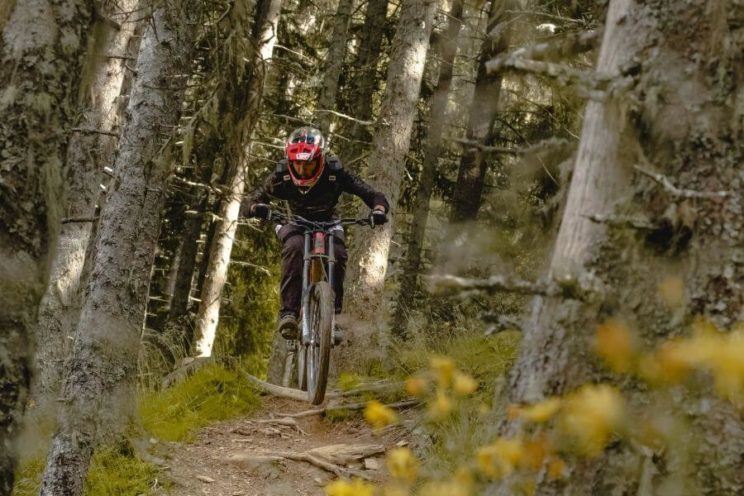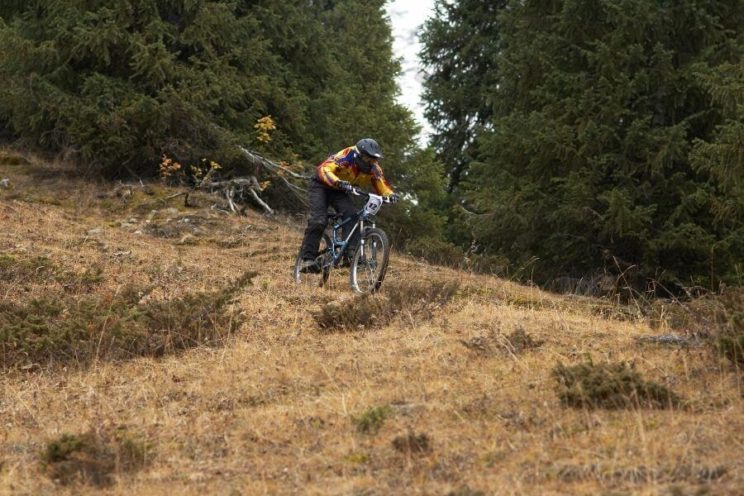Jumping is one of the most complicated mountain bike technical resources, but at the same time it is a technique that is necessary to learn and have it to successfully overcome certain situations. It can be very useful to overcome obstacles or other irregularities of the terrain quickly and effectively.
Although sometimes he sins from considering the jump as an aesthetic eccentricity or facing the gallery, the truth is that jumping correctly is a technical resource of mountain cycling that must be dominated if what you want is to have a good management of your bicycle In all kinds of situations.
Through a jump you can save land cuts, cut, sudden changes of flush or obstacles such as rocks and trunks. All of them are obstacles that you can find on any Mountain Bike route, not only in Enduro sections. On a flat forest track, for example, you can find some unexpected pothole or undercut. Even in the asphalt.
Thus, we give you some very practical tips so that you confronts the passage of these obstacles or jumps with the wheels taken from the ground. Normal situations of any classic mountain cycling route. In this article we will not talk to you, therefore, of jumps impossible for descent,
Bike Park either
Pump Track, but how to execute the jump technique with your bicycle on conventional routes and situations.
The 4 basic steps to jump properly with your mountain bike

Removing the wheels of the ground and elevate in the air to overcome obstacles and irregularities of the land is not an isolated technique, but a set of them. To learn to jump properly we recommend you take the following steps:
1. Keep flexed arms and legs
The posture on the bicycle at the time of the jump is crucial to do it safely. Firmly grab the handlebar, slightly flex the elbows and knees and slightly throw the body back to the rear axle. In this way you will move your weight and your center of gravity.
2. Moderate speed
The jump begins to always prepare 3 to 5 seconds before reaching the obstacle. In this previous zone, in addition to putting the step one into practice, you have to maintain a moderate but constant speed that does not make your bicycle out of control or your balance by inertia. Touch the rear brake always before reaching the jump and forget about using the striker. Keep in mind that what it is about is to make the leap at an adequate and constant speed, not to do it at the maximum possible speed.
3. Control the vertical impulse
At the time of rising from the floor, impuls with your bike in a moderate way, up, using the arms and legs as if they were docks. A small push will suffice for the bike to rise by inertia or by the slope of the land itself.
Never frenzy just at the time the bicycle returns to the ground
4. Balances the wheels when falling to the ground
This small impulse will allow you to balance the inclination of both wheels so that the reception of the jump (the moment in which you will fall to the ground again) is done with both playing the ground at the same time, which will avoid imbalances or that the bike is shot forward.
Help yourself with your arms and legs flexed to cushion the impact and then start stopping to adapt the speed or stop in case it is necessary. Never frenzy during or right at the time of reception.
Types of jumps depending on the obstacle

These four steps we have seen before are the general steps in the execution of any jump with a bicycle. But given certain obstacles there are variations of some or several of them to adapt to each situation. We explain how to jump in the most frequent obstacles of a Mountain Bike route.
Bunny Hop, the multipurpose jump of the Mountain Bike
He
Bunny Hop or 'Rabbit Salto' is a very recurring type of jump in this sport and that allows you to overcome obstacles safely without slowing down your rhythm or speed. It is about raising the bicycle from the ground with the strength of your own body, without the help of a ramp. In other words, a height but bicycle jump.
It is very useful for overcoming undercuts in the middle of a road, trunks or roots and similar elements. Its execution technique implies a greater body impulse at the time of raising the bike, since you will not have any external help to boost.
He Bunny Hop will allow you to jump potholes or other small obstacles without losing rhythm
The jump implies a first elevation of the front wheel, followed by the rear to keep the bike in the air and overcome the obstacles. The reception must be made at the same time with both wheels.
Natural ramp jump
On many occasions you will run into some abrupt undulation of the ramp -shaped terrain, whose fastest and most effective way to overcome will be with a jump. To do this, we will have to resort more than ever to the four basic steps of the beginning, moderating the strength of the impulse at the time of the jump.
At the time of reception it is very likely that it is not flat. In that case it is advisable to use the body to adapt the fall of the wheels to the slope of the firm, throw it slightly forward and thus fall with both at the same time. Don't lean too much on the front wheel. In case of imbalance, it is safer to fall first with the rear than with the front.
Corted jump or Drops
Finally, we must stop in one of the most complicated steps or obstacles that generate more fear on a Mountain Bike route. It is the cuts or
Dropps, Suddenly cut on the path that generate a vertical fall until the continuation of the path itself.
The jump technique at this point is a bit different from that of the conventional jump or the
Bunny Hop. Here more has a maximum confidence, moderating the speed and impulse of the jump must be almost testimonial. Drop and balance at the same time the bicycle for a simultaneous reception of both wheels is the secret of a good jump of cut.
In this practical Bikechck video you can learn several tricks to lose the fear of the cuts and jump them with confidence and ease:
https://youtu.be/LZxmUDIVuuk
Final Council: Practice in safe environments
The jump technique is not simple to dominate and, as we have seen, there are several types of obstacles or ramps that require some variations in the technique. The best thing to learn and get used to jumping is to do it with simple obstacles to begin with: potholes and ramps of low height and simple cuts with flat reception.
Little by little you can encourage you with routes that include jumps of greater difficulty. If for any circumstance you do not see yourself capable or sure to do well for time, examine the state of the jump or cut, its reception and visualize the traced. This will make you see the clearest situation and assemble confidence to cross the obstacle.
We also recommend making sessions or technique routes with jumps accompanied by a
biker more experienced. This can mark the speed and drawn, worrying just to adopt the appropriate posture to perform them in a controlled and safe way.
 Removing the wheels of the ground and elevate in the air to overcome obstacles and irregularities of the land is not an isolated technique, but a set of them. To learn to jump properly we recommend you take the following steps:
Removing the wheels of the ground and elevate in the air to overcome obstacles and irregularities of the land is not an isolated technique, but a set of them. To learn to jump properly we recommend you take the following steps:
 These four steps we have seen before are the general steps in the execution of any jump with a bicycle. But given certain obstacles there are variations of some or several of them to adapt to each situation. We explain how to jump in the most frequent obstacles of a Mountain Bike route.
These four steps we have seen before are the general steps in the execution of any jump with a bicycle. But given certain obstacles there are variations of some or several of them to adapt to each situation. We explain how to jump in the most frequent obstacles of a Mountain Bike route.















